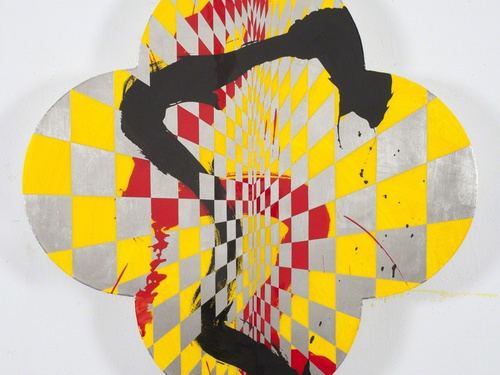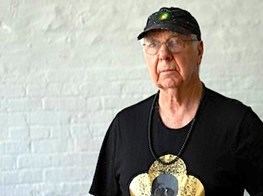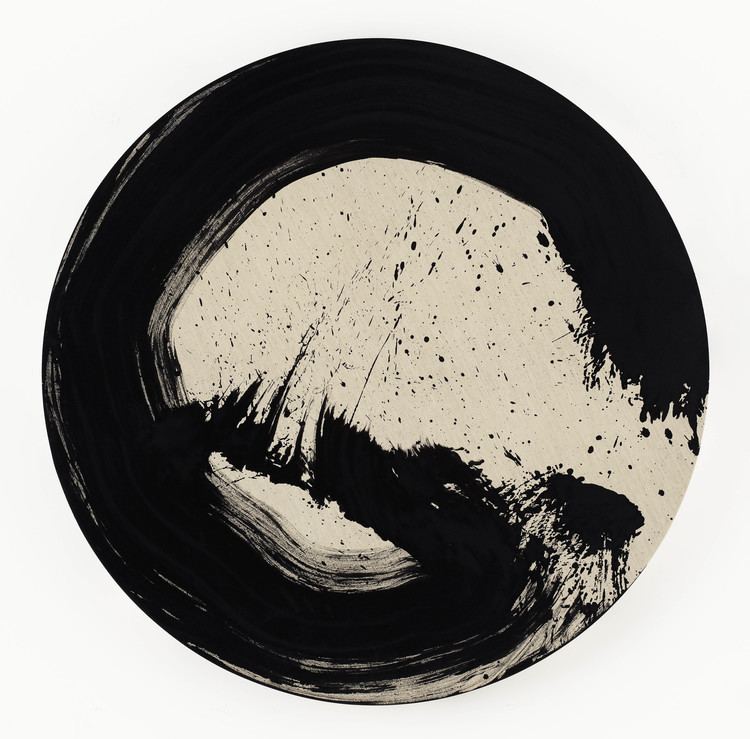Name Max Gimblett | Role Artist | |
 | ||
Education San Francisco Art Institute, Auckland Grammar School | ||
Max gimblett the brush of all things part 1 of 4
Maxwell Harold "Max" Gimblett (born 5 December 1935 is a New Zealand artist. He is well known for his paintings, sculpture, ink drawings, works on paper, and artist’s books.
Contents
- Max gimblett the brush of all things part 1 of 4
- Nihon New York Episode 02 Zen in America Painting with NYCs Max Gimblett
- Life and work
- References

Nihon New York - Episode 02 - Zen in America: Painting with NYC's Max Gimblett
Life and work

Gimblett was born in Auckland, New Zealand, a second-generation New Zealander.

Gimblett attended King's School and Auckland Grammar School in 1950, and left New Zealand in 1956 to travel throughout Europe until 1961, with a brief return to Auckland for a year in 1958-59. Traveling to the America's in 1962, Gimblett apprenticed with master potter Roman Bartkiw in Toronto, Canada and then worked with master ceramist Merton Chambers from 1962 to 1964. In 1964 he married Barbara Kirshenblatt. That same year he studied drawing at the Ontario College of Art, Toronto. In 1965 he studied painting at the San Francisco Art Institute, San Francisco, California.

From 1967 to 1970, he lived and painted in Bloomington, Indiana where Barbara Kirshenblatt-Gimblett was completing her PhD in Folklore Studies. From 1970 to 1972 he resided in Austin, Texas, where Barbara was an associate professor in the English department at the University of Texas, Austin.
Gimblett moved to New York in 1972 and in 1974 formed an affinity and enduring friendship with the experimental filmmaker and kinetic sculptor Len Lye, who was a fellow New Zealander. Gimblett continued to support his work after Lye's death and in 1990 he became a trustee of the Len Lye Foundation based in New Plymouth, New Zealand.
Gimblett continued to live in New York returning to New Zealand only for brief visits. In 1979 Gimblett became an American Citizen.
Gimblett's work is rich and inventive. He is known for his great technical and stylistic range: the monochrome, geometric abstraction, the calligraphic and figurative expressionism all find a place in the work. He uses novel shaped supports: ovals, circles, and rings. However the quatrefoil is the shape he has really made his own.
"The quatrefoil is defined ..." writes Thomas McEvilley, "as ‘a compound leaf or flower consisting of four (usually rounded) leaflets or petals radiating from a common center.’ Most of Gimblett’s works in this format are geometrised, meaning that the petals of the flowers are not merely rounded in an organic sense but are composed of four perfect circles that intersect at a single point. It is a format which virtually no other modern artist has emphasized."
Gimblett draws freely on Buddhism, Christianity, classical mythology, and alchemy, Jung. His work can be understood in the context of Western Buddhism.
"The Influence of Zen," writes Thomas McEvilley, "for example, seems natural to Gimblett, and carries with it an echo of Asia’s proximity to New Zealand, but also can be traced partly to American artists with West Coast connections such as Clyfford Still and Mark Tobey. Gimblett has made a harmonious post-war synthesis of America and Japan."
Gimblett’s first solo painting exhibition was at Dave Hickey’s A Clean Well Lighted Place in Austin in 1971.
In 1975 he joined the Cuningham Ward Gallery, New York where he exhibited with Ross Bleckner, John Walker, David Reed, John Elderfield, and Lynton Wells.
In 1989 he was awarded the National Endowment for the Arts Painting Fellowship.
In 1990 Gimblett joined the Haines Gallery, San Francisco and the Gow Langsford Gallery, Auckland. Both of these galleries continue to represent him today.
In 1991 he participated in a residency at The Rockefeller Foundation, Study and Conference Center, Bellagio, Lake Como, Italy.
Gimblett was a J. Paul Getty associate at the Getty Center for the History of Art and the Humanities, Santa Monica, in 1991-1992.
Craig Potton Publishing published his first monograph in 2002 in association with Gow Langsford Gallery (Auckland), which includes essays by John Yau and Wystan Curnow.
"Max Gimblett: The Brush of All Things", a major survey of his work, opened at the Auckland Art Gallery Toi O Tamaki, Auckland, New Zealand in 2004 and traveled to the City Gallery, Wellington. Thomas McEvilley and Wystan Curnow contributed essays to the catalog, which also contained an interview with Barbara Kirshenblatt-Gimblett.
"Here is how it happened. Gimblett stepped up to the 80 inch circular canvas and while that murderous train bore down on him, he painted The Wheel in less than one minute. This is no exaggeration, in on rapturous, fearless moment, which left him with time to spare." Wystan Curnow describes Gimblett painting The Wheel, an Enso, in his essay An Exhilaration of the Spirit, in Max Gimblett, monograph, 2002, published by Craig Potton Publishing in association with Gow Langsford Gallery, also including an essay by John Yau.
In January 2006 Max Gimblett took refuge in the precepts of Buddha.
"Gimblett’s absorption in Asian art connects him to three unique figures in American art: Morris Graves, John McLaughlin, and Ad Reinhardt," writes Yau, "One reason Gimblett shares a deep connection with these three seminal figures is because all of them embarked upon an intense and prolonged study of different schools of Buddhism and Buddhist art."
He was appointed to the honorary position of Visiting Professor of Art to the National Institute of Creative Arts and Industries, Auckland University, Auckland, New Zealand in 2003.
Gimblett was the Laila Foundation Artist in Residence at HuiPress, Maui, HI in July 2008, making a suite of Enso etchings.
His work was included in the Guggenheim Museum’s exhibition titled "The Third Mind: American Artists Contemplate Asia, 1860 to 1989" which was open from 30 January to 19 April 2009. The exhibition was curated by Alexandra Munroe, the museum’s first Senior Curator of Asian Art.
For ANZAC's 100th Anniversary, he created the "Art of Remembrance" public art - solid brass quatrefoil to represent each Kiwi soldier that served in WW1 - on the exterior of St. David's on Kyber Pass in Auckland. He was named an Officer of the New Zealand Order of Merit for services to art in the 2015 Queen's Birthday Honours.
Gimblett has collaborated with a number of other artists including Warwick Freeman, Lewis Hyde, Judith Ivory, Matt Jones (artist), Win Knowlton, Alan Loney, Chris Martin, Eileen Tabios, Michael Dai Ryu Wenger Great Dragon, and John Yau.
